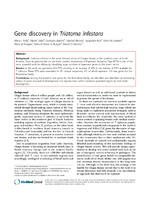Please use this identifier to cite or link to this item:
http://sgc.anlis.gob.ar/handle/123456789/493| DC Field | Value | Language |
|---|---|---|
| dc.contributor.author | Avila, Maria L. | |
| dc.contributor.author | Tekiel, Valeria | |
| dc.contributor.author | Moretti, Georgina | |
| dc.contributor.author | Nicosia, Soledad | |
| dc.contributor.author | Bua, Jacqueline | |
| dc.contributor.author | Lammel, Estela M. | |
| dc.contributor.author | Stroppa, Maria M. | |
| dc.contributor.author | Gerez de Burgos, Nelia M. | |
| dc.contributor.author | Sanchez, Daniel O. | |
| dc.date.accessioned | 2013-05-22T16:38:26Z | |
| dc.date.available | 2013-05-22T16:38:26Z | |
| dc.date.issued | 2011 | |
| dc.identifier.uri | http://sgc.anlis.gob.ar/handle/123456789/493 | |
| dc.description | Background: Triatoma infestans is the most relevant vector of Chagas disease in the southern cone of South America. Since its genome has not yet been studied, sequencing of Expressed Sequence Tags ( ESTs) is one of the most powerful tools for efficiently identifying large numbers of expressed genes in this insect vector. Results: In this work, we generated 826 ESTs, resulting in an increase of 47% in the number of ESTs available for T. infestans. These ESTs were assembled in 471 unique sequences, 151 of which represent 136 new genes for the Reduviidae family. Conclusions: Among the putative new genes for the Reduviidae family, we identified and described an interesting subset of genes involved in development and reproduction, which constitute potential targets for insecticide development. | en_US |
| dc.rights | openAccess | en_US |
| dc.source | Parasites & Vectors, 2011, 4, 39. | en_US |
| dc.title | Gene discovery in Triatoma infestans | en_US |
| item.fulltext | With Fulltext | - |
| item.grantfulltext | open | - |
| Appears in Collections: | Preproducción Publicaciones INP | |
Files in This Item:
| File | Description | Size | Format | |
|---|---|---|---|---|
| Parasites&Vectors,2011,4,39..pdf | 690.53 kB | Adobe PDF |  View/Open |
Page view(s)
178
checked on Nov 14, 2025
Download(s)
34
checked on Nov 14, 2025
Google ScholarTM
Check
Items in DSpace are protected by copyright, with all rights reserved, unless otherwise indicated.

